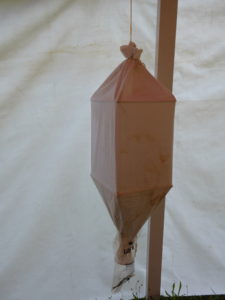June 14, 2018 Fourth day ASIW
Habitats
Today, we spent a fair amount of time investigating the pond with our morning class (and we walked again to the ant hill for the afternoon class). I also started examining the insects coming out of the Winkler eclector. We sifted rotting wood (mostly brown rot and red rot logs) yesterday. The device is shown below. Not as many species were found as expected. I did note the tent was rather warm. I fear that the sifted material dried out more quickly than anticipated.

Even More Insect taxa encountered
As we explored the fields and woods, we continued to put together a list of insects we encountered. We were able to identify most to family level. I have organized these below (by order). This is an updated list (new families/ orders encountered today are marked with an asterisk). This list expands on the insects encountered on Monday, Tuesday, and Wednesday.
For those who are curious about our running total. Over the course of four days, we have encountered:
- 17 orders of insects (16 if you exclude Collembola)
- 79 families of insects (78 if you exclude Collembola)
Again, most of these insects were captured by students in the Illinois Insects classes (both major [morning] and minor [afternoon] classes). Since they are just learning about insects this week, I find this to be a most impressive list so far.
Class Entognatha – Subclass Collembola
Order Entomobryomorpha
- Family Entomobryidae
Class Insecta
Order Blattodea
- Family Ectobiidae (wood cockroach)
Order Coleoptera
- Family Buprestidae
- Family Cantharidae (soldier beetles)
- Family Carabidae (ground beetles and tiger beetles)
- Family Cerambycidae (long horn beetles)
- Tetraopes tetraopthalamus [milkweed beetle]
- Family Chrysomelidae (leaf beetles)
- Family Cleridae (checkered beetles) *
- Family Coccinellidae (lady beetles)
- Family Curculionidae (weevils)
- Family Dytiscidae (predaceous diving beetles)
- Family Elateridae (click beetles)
- Family Gyrinidae (whirligig beetles)
- Family Haliplidae (crawling water beetles)
- Family Lampyridae (fireflies)
- Family Scarabaeidae (scarab beetles)
- Popillia japonica [Japanese beetle]
- Family Silphidae
Order Dermaptera
- Family Forficulidae (earwigs)
Order Diptera
- Family Asilidae (robber flies)
- Family Bombyliidae (bee flies)
- Family Culicidae (mosquitoes)
- Family Dolicopodidae (long legged flies)
- Family Muscidae (house flies)
- Family Mycropezidae (stilt-legged flies) *
- Family Rhagionidae
- Family Tabanidae (horse flies)
- Family Tachinidae *
- Family Tephritidae
- Eurosta solidaginis (goldenrod gall fly)
- Family Tipulidae (crane flies)
Order Ephemeroptera
- Family Ephemeridae
Order Hemiptera
- Family Aradidae (flat bugs) *
- Family Belostomatidae (giant water bugs)
- Family Cercopidae (spittle bugs)
- Family Cicadellidae (leaf hoppers)
- Family Coreidae (leaf-footed bugs)
- Family Corixidae (water boatmen)
- Family Gelastocoridae (toad bugs)
- Family Gerridae (water striders) *
- Family Membracidae (tree hoppers)
- Family Myridae (plant bugs)
- Family Naucoridae (creeping water bugs)
- Family Nabidae (damsel bugs)
- Family Nepidae (water scorpions) *
- Family Reduviidae (assassin bugs)
- Family Scutelleridae (shield-backed bugs)
- Family Tingidae (lace bugs)
- Family Veliidae (riffle bugs)
Order Hymenoptera
- Family Apidae (bumble bees and honey bees)
- Family Bethylidae
- Family Braconidae *
- Family Evaniidae (ensign wasps) *
- Family Formicidae (ants)
- Formica pallidefulva
- Formica exsectoides
- Lasius neoniger
- Leptothorax curvispinosus
- Monomorium minimum
- Myrmecina americana
- Ponera pennsylvanica
- Strumigenys sp.
- Family Ichneumonidae *
- Family Sphecidae (thread waisted wasps) *
- Family Tenthredinidae (sawflies)
- Family Vespidae (potter wasps and others)
Order Lepidoptera
- Family Erebidae
- Haploa confusa
- Haploa confusa
- Family Geometridae (geometer moths)
- Family Lycaenidae [blues]
- Family Nymphalide
- Asterocampa celtis [hackberry emperor butterfly]
- Checkerspot butterfly
- Speyeria cybele [great spangled fritillary]
- Family Papilionidae (swallowtails)
- Family Pieridae (sulphurs and whites)
- Family Pterophoridae (plume moths) *
- Family Pyralidae
- Family Satyridae (wood nymphs)
- Family Tortricidae *
Order Mantodea
- Family Mantidae
- Tenodera sinensis [Chinese mantis nymphs]
Order Mecoptera
- Family Panorpidae (scorpion-flies)
Order Neuroptera
- Family Chrysopidae (green lacewings)
Order Odonata
- Family Aeschnidae (darners)
- Family Coenagrionidae (damselflies)
- Family Libellulidae (skimmer dragonflies)
Order Orthoptera
- Family Acrididae (band-wing grasshoppers)
- Family Gryllidae
- Phyllopalpus pulchellus [handsome trig]
- Family Rhaphidophoridae (cave crickets)
- Family Tettigoniidae (katydids)
- Family Tridactylidae (pygmy mole crickets)
Order Phasmatodea
- Family Diapheromeridae
- Diapheromera femorata (common walkingstick)
Order Plectoptera *
- Family Nemouridae (spring stoneflies) *
Order Thysanoptera
- Family Thripidae (thrips)
Other Arthorpods
- Diplopoda (millipedes) *
- Isopods
- Geophilomorph centipede
- Scolopendromorph centipede
- Spiders (mostly wolf spiders and relatives and Salticidae)
- Geolycosa wrighti was the large brown spider we found in the afternoon)
We covered a lot of ground today as well. My total mileage was 6 miles (not the usual 7). Coupled with the 27 miles I walked previously, I have now walked over 33 miles at the Sun Foundation in 2018.